This is an old revision of this page, as edited by Sengkang (talk | contribs) at 01:57, 26 October 2006 (Revert to revision 83757627 dated 2006-10-26 01:27:19 by Algebra using popups). The present address (URL) is a permanent link to this revision, which may differ significantly from the current revision.
Revision as of 01:57, 26 October 2006 by Sengkang (talk | contribs) (Revert to revision 83757627 dated 2006-10-26 01:27:19 by Algebra using popups)(diff) ← Previous revision | Latest revision (diff) | Newer revision → (diff) This article is about Earth's moon. For moons in general, see natural satellite. For other uses, see Moon (disambiguation).
 The Moon as seen from Earth | |||||||
| Orbital characteristics | |||||||
|---|---|---|---|---|---|---|---|
| Orbital circumference | 2,413,402 km (0.016 AU) | ||||||
| Eccentricity | 0.0554 | ||||||
| Perigee | 363,104 km (0.0024 AU) | ||||||
| Apogee | 405,696 km (0.0027 AU) | ||||||
| Revolution period | 27.321 66155 d (27 d 7 h 43.2 min) | ||||||
| Synodic period | 29.530 588 d (29 d 12 h 44.0 min) | ||||||
| Avg. Orbital Speed | 1.022 km/s | ||||||
| Max. Orbital Speed | 1.082 km/s | ||||||
| Min. Orbital Speed | 0.968 km/s | ||||||
| Inclination | varies between 28.60° and 18.30° (5.145 396° to ecliptic) see below | ||||||
| Longitude of the ascending node |
regressing, 1 revolution in 18.6 years | ||||||
| Argument of perigee | progressing, 1 revolution in 8.85 years | ||||||
| Satellite of | Earth | ||||||
| Physical characteristics | |||||||
| Equatorial diameter | 3,476.2 km (0.273 Earths) | ||||||
| Polar diameter | 3,472.0 km (0.273 Earths) | ||||||
| Oblateness | 0.0012 | ||||||
| Surface area | 3.793×10 km² (0.074 Earths) | ||||||
| Volume | 2.1958×10 km³ (0.020 Earths) | ||||||
| Mass | 7.347 673×10 kg (0.0123 Earths) | ||||||
| Mean density | 3,346.2 kg/m | ||||||
| Equatorial gravity | 1.622 m/s (0.1654 gee) | ||||||
| Escape velocity | 2.38 km/s | ||||||
| Rotation period | 27.321 661 d (synchronous) | ||||||
| Rotation velocity | 16.655 km/h (at the equator) | ||||||
| Axial tilt | 1.5424° to ecliptic see Orbit | ||||||
| Albedo | 0.12 | ||||||
| Magnitude | -12.74 | ||||||
| Surface temp. |
| ||||||
| Bulk composition of the Moon's
mantle and crust | |||||||
| estimated, weight percent | |||||||
| Oxygen | 42.6 % | ||||||
| Magnesium | 20.8 % | ||||||
| Silicon | 20.5 % | ||||||
| Iron | 9.9 % | ||||||
| Calcium | 2.31 % | ||||||
| Aluminium | 2.04 % | ||||||
| Nickel | 0.472 % | ||||||
| Chromium | 0.314 % | ||||||
| Manganese | 0.131 % | ||||||
| Titanium | 0.122 % | ||||||
| Atmospheric characteristics | |||||||
| Atmospheric pressure | 3 × 10kPa | ||||||
| Helium | 25 % | ||||||
| Neon | 25 % | ||||||
| Hydrogen | 23 % | ||||||
| Argon | 20 % | ||||||
| Methane |
trace | ||||||
The Moon is Earth's only natural satellite. It has no formal English name other than "the Moon", although it is occasionally called Luna (Latin for moon), or Selene (Greek for moon), to distinguish it from the generic term "moon" (referring to any of the various natural satellites of other planets). Its symbol is a crescent. The related adjective for the Moon is lunar (again from the Latin root), but this is not found in combination, the combining forms seleno-/-selene (again from the Greek) and -cynthion (from the Lunar deity Cynthia) being used in terms relating to the Moon in various other contexts (e.g. aposelene, selenocentric, pericynthion, etc.).
The average distance from the Moon to the Earth is 384,401 kilometres (238,857 mi). The Moon's diameter is 3,476 kilometres (2,160 mi). Reflected sunlight from the Moon's surface reaches Earth in approximately 1.3 seconds (at the speed of light). The Moon is the Solar System's fifth largest moon, both by diameter and mass, ranking behind Ganymede, Titan, Callisto, and Io.
The first man-made object to impact the lunar surface was Luna 2 in 1959; the first photographs of the normally occluded far side of the Moon were made by Luna 3 in the same year. The first spacecraft to perform a successful lunar soft landing was Luna 9 in 1966. The first manned mission to orbit the Moon was Apollo 8, and the first people to land on the Moon came aboard Apollo 11 in 1969. It is the only celestial body other than the Earth upon which humans have set foot.
The two sides of the Moon
The Moon is in synchronous rotation, meaning that it keeps nearly the same face turned toward Earth at all times (there is a small variation, called libration). The side of the Moon that faces Earth is called the near side, and the opposite side is called the far side. The far side is also sometimes called the dark side, which means unknown and hidden, and not lacking light as might seem to be implied by the name; in fact, the far side receives (on average) slightly more sunlight than the near side due to lunar eclipse. Spacecraft are cut off from direct radio communication with Earth when on the far side of the Moon due to line-of-sight propagation. One distinguishing feature of the far side is its almost complete lack of maria (singular: mare), which are the dark albedo features.
| 90° W | Near side | |
|---|---|---|
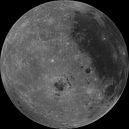
|

| |

|

| |
| 90° E | Far side |
Orbit and relationship to Earth

The Moon makes a complete orbit about the Earth approximately once every 27.3 days. It is at present in its Template:Moon phase. Unlike most satellites of other planets, the Moon orbits near the ecliptic and not the Earth's equatorial plane.
The Earth and Moon have many physical effects upon one another, including the tides. Most of the tidal effects seen on the Earth are caused by the Moon's gravitational pull, with a smaller contribution from the Sun. Tidal effects result in an increase of the mean Earth-Moon distance, over long periods of time, of about 4 metres per century.
The Earth-Moon system may be considered to be a double planet rather than a planet-moon system. This is due to the exceptionally large size of the Moon relative to its host planet; the Moon is one-fourth the diameter of Earth and 1/81 the mass. However, as the barycenter is located within the Earth, the Earth-Moon system does not meet the official IAU definition of a double planet.
Origin and history
The inclination of the Moon's orbit makes it implausible that the Moon formed along with the Earth or was captured later; its origin is the subject of some scientific debate.
Early speculation proposed that the Moon broke off from the Earth's crust due to centrifugal force, leaving an ocean basin (presumed to be the Pacific Ocean) behind as a scar. This concept requires too great an initial spin of the Earth and the presumption of a Pacific origin is not compatible with the geological standard model, the theory of plate tectonics. Others speculated the Moon formed elsewhere and was captured into Earth's orbit. Two of the other theories include the coformation or condensation theory and the impact theory, which speculates that the Moon formed from the debris that resulted from a collision between the early Earth and a planetesimal.

The coformation or condensation hypothesis posits that the Earth and the Moon formed together at about the same time from the primordial accretion disk, the Moon forming from material surrounding the coalescing proto-Earth, similar to the way the planets formed around the Sun. Some suggest that this hypothesis fails to adequately explain the depletion of iron in the Moon.
Recently, the giant impact hypothesis has been considered a more viable scientific hypothesis for the Moon's origin than the coformation or condensation hypothesis. The Giant Impact hypothesis holds that the Moon formed from the ejecta resulting from a collision between a very early, semi-molten Earth and a planet-like object the size of Mars, which has been referred to as Theia or Orpheus. The material ejected from this impact would have gathered in orbit around Earth and formed the Moon. This hypothesis is bolstered by two main observations: First, the composition of the Moon resembles that of Earth's crust, though it has relatively few heavy elements that would have been present if it formed by itself out of the same material from which Earth formed. Second, through radiometric dating, it has been determined that the Moon's crust formed between 20 and 30 million years after that of Earth, despite its smallness and associated larger loss of internal heat, although it has been suggested that this hypothesis does not adequately address the abundance of volatile elements in the Moon.
At that time the Moon was much closer to the Earth and strong tidal forces deformed the once molten sphere into an ellipsoid, with the major axis pointed towards Earth. When the Moon started to cool a solid crust was formed along its surface, but its molten interior remained displaced in the direction of the Earth. Due to this effect, the crust on the near side was much thinner than on the far side. Especially during the late heavy bombardment, around 3.8 to 4 billion years ago, many large meteorites were able to penetrate the thin crust of the near side but only very few could do so on the far side. Where the crust was perforated the hot lavas from the interior oozed out and spread over the surface, only to cool later into the maria (or seas) as we know them today. This explains the lack of maria on the far side.
The geological epochs of the Moon are defined based on the dating of various significant impact events in the Moon's history. The period of the late heavy bombardment is determined by analysis of craters and Moon rocks. In 2005, a team of scientists from Germany, the United Kingdom, and Switzerland measured the Moon's age at 4527 ± 10 million years, which would imply that it was formed only 30 to 50 million years after the origin of the solar system.
Physical characteristics
Main article: Geology of the MoonComposition
It is held that more than 4.5 billion years ago, the surface of the Moon was a liquid magma ocean. Scientists think that one component of lunar rocks, called KREEP (potassium, rare earth elements, and phosphorus), represents the last chemical remnant of that magma ocean. KREEP is actually a composite of what scientists term incompatible elements: those that cannot fit into a crystal structure and thus were left behind, floating to the surface of the magma. For the researchers, KREEP is a convenient tracer, useful for reporting the story of the volcanic history of the lunar crust and chronicling the frequency of impacts by comets and other celestial bodies.
The lunar crust is composed of a variety of primary elements, including uranium, thorium, potassium, oxygen, silicon, magnesium, iron, titanium, calcium, aluminium, and hydrogen, as determined by spectroscopy.
A complete global mapping of the Moon for the abundance of these elements has never been performed. However, some spacecraft have done so for portions of the Moon; Galileo did so when it flew by the Moon in 1992. The overall composition of the Moon is believed to be similar to that of the upper parts of the Earth other than a depletion of volatile elements and of iron.
Selenography
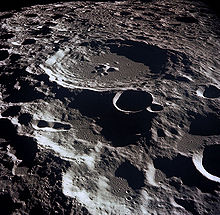
When observed with Earth based telescopes, the Moon can be seen to have some 30,000 craters having a diameter of at least 1 km, but close up observation from lunar orbit reveals a multitude of ever smaller craters. Most are hundreds of millions or billions of years old; the lack of atmosphere, weather and recent geological processes ensures that most of them remain permanently preserved. In the lunar terrae, it is indeed impossible to add a crater of any size without obliterating another; this is termed saturation.
The largest crater on the Moon, and indeed the largest known crater within the solar system, forms the South Pole-Aitken basin. This crater is located on the far side, near the South Pole, and is some 2,240 kilometres in diameter, and 13 kilometres in depth.
The dark and relatively featureless lunar plains are called maria, Latin for seas, since they were believed by ancient astronomers to be water-filled seas. They are actually vast ancient basaltic lava flows that filled the basins of large impact craters. The lighter-colored highlands are called terrae. Maria are found almost exclusively on the Lunar nearside, with the Lunar far side having only a few scattered patches.
Blanketed atop the Moon's crust is a dusty outer rock layer called regolith, the result of rocks shattered by billions of years of impacts. Both the crust and regolith are unevenly distributed over the entire Moon. The crust ranges from 60 kilometres (38 mi) thick on the near side to 100 kilometres (63 mi) on the far side, and the regolith varies from 3 to 5 metres (10 to 16 ft) deep in the maria to 10 to 20 metres (33 to 66 ft) deep in the highlands.
In 2004, a team led by Dr. Ben Bussey of Johns Hopkins University using images taken by the Clementine mission determined that four mountainous regions on the rim of the 73 km-wide Peary crater at the Moon's north pole appeared to remain illuminated for the entire Lunar day. These unnamed mountains of eternal light are possible due to the Moon's extremely small axial tilt, which also gives rise to permanent shadow at the bottoms of many polar craters. No similar regions of eternal light exist at the less mountainous south pole, although the rim of Shackleton crater is illuminated for 80% of the lunar day. Clementine's images were taken during the northern Lunar hemisphere's summer season, and it remains unknown whether these four mountains are shaded at any point during their local winter season.
Dating of the lunar impact events through Ar/Ar isotope analysis of glass spherules, created during the impacts, showed a high impact number in early lunar history and in the last 400 million years.
Presence of water
Over time, comets and meteoroids continuously bombard the Moon. Many of these objects are water-rich. Energy from sunlight splits much of this water into its constituent elements hydrogen and oxygen, both of which usually fly off into space immediately. However, it has been hypothesized that significant traces of water remain on the Moon, either on the surface, or embedded within the crust. The results of the Clementine mission suggested that small, frozen pockets of water ice (remnants of water-rich comet impacts) may be embedded unmelted in the permanently shadowed regions of the lunar crust. Although the pockets are thought to be small, the overall amount of water was suggested to be quite significant — 1 km³.
Some water molecules, however, may have literally hopped along the surface and become trapped inside craters at the lunar poles. Due to the very slight "tilt" of the Moon's axis, only 1.5°, some of these deep craters never receive any light from the Sun — they are permanently shadowed. Clementine has mapped craters at the lunar south pole which are shadowed in this way. It is in such craters that scientists expected to find frozen water. Water ice can be mined and then split into hydrogen and oxygen by solar panel-equipped electric power stations or a nuclear generator. The presence of usable quantities of water on the Moon is an important factor in rendering lunar habitation cost-effective, since transporting water (or hydrogen and oxygen) from Earth would be prohibitively expensive.
The equatorial Moon rock collected by Apollo astronauts contained no traces of water. In the permanently shadowed regions, however, Lunar Prospector results indicate the presence of hydrogen due to its neutron signature. This corroborated radar reflections from the Clementine probe, leading some to postulate that the hydrogen was in the form of water ice (http://lunar.arc.nasa.gov/results/ice/eureka.htm). Recent radar observations with the Arecibo planetary radar showed that the Clementine radar returns were from rocks ejected from young craters, rocks which did not follow permanently-shadowed crater floors. This indicates that the neutron results are primarily from hydrogen in forms other than ice, such as trapped hydrogen molecules or organics. However, the researchers do not exclude the possibility of minor ice sites.
Magnetic field
Compared to that of Earth, the Moon has a very weak magnetic field. While some of the Moon's magnetism is thought to be intrinsic (such as a strip of the lunar crust called the Rima Sirsalis), collision with other celestial bodies might have imparted some of the Moon's magnetic properties. Indeed, a long-standing question in planetary science is whether an airless solar system body, such as the Moon, can obtain magnetism from impact processes such as comets and asteroids. Magnetic measurements can also supply information about the size and electrical conductivity of the lunar core — evidence that will help scientists better understand the Moon's origins. For instance, if the core contains more magnetic elements (such as iron) than Earth, then the impact theory loses some credibility (although there are alternate explanations for why the lunar core might contain less iron).
Atmosphere
The Moon has a relatively insignificant and tenuous atmosphere. One source of this atmosphere is outgassing — the release of gases, for instance radon, which originate deep within the Moon's interior. Another important source of gases is the solar wind, which is briefly captured by the Moon's gravity.
Eclipses
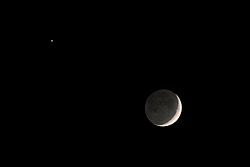
Eclipses happen only if Sun, Earth, and Moon are lined up. Solar eclipses can only occur near a new moon; lunar eclipses can only occur near a full moon.
The angular diameters of the Moon and the Sun as seen from Earth overlap in their variation, so that both total and annular solar eclipses are possible. In a total eclipse, the Moon completely covers the disc of the Sun and the solar corona becomes visible to the naked eye.
Since the distance between the Moon and the Earth is very slightly increasing over time, the angular diameter of the Moon is decreasing. This means that hundreds of millions of years ago the Moon could always completely cover the Sun on solar eclipses so that no annular eclipses were possible. Likewise, about 600 million years from now (assuming that the angular diameter of the Sun will not change), the Moon will no longer cover the Sun completely and total eclipses will not occur.
Occultation of stars
Main article: OccultationThe Moon is continuously blocking our view of the sky directly behind it. The Moon blocks about a 1/2 degree wide circular area. When a bright star or planet passes behind the Moon it is occulted or hidden from view. A solar eclipse is an occultation of the Sun. Because the Moon is close to Earth, occultations of stars are not visible everywhere. Because of the moving nodes of the lunar orbit, each year different stars are occulted.
Observation of the Moon

During the brightest full moons, the Moon can have an apparent magnitude of about −12.6. For comparison, the Sun has an apparent magnitude of −26.8. When the Moon is in a quarter phase, its brightness is not one half of a full Moon. It is only about 1/10 of that, because the amount of solar radiation reflected towards the Earth is highly reduced by the shadows projected by the higher parts of the Moon over the lower ones.
The Moon appears larger when close to the horizon. This is a purely psychological effect (see Moon illusion). The angular diameter of the Moon from Earth is about one half of one degree, and is actually about 1.5% smaller when the Moon is near the horizon than when it is high in the sky (because it is farther away by up to 1 Earth radius).
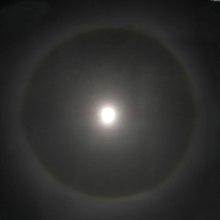
Another quirk of the visual system causes us to see the Moon as almost pure white, when in fact it reflects only about 7% of the light falling on it (about as dark as a lump of coal). It has a very low albedo. Color constancy in the visual system recalibrates the relations between colors of an object and its surroundings; however, there is nothing next to the Moon to reflect the light falling on the Moon, therefore it is perceived as the brightest object visible. We have no standard to compare it to. An example of this is that, if you used a narrow beam of light to illuminate a lump of coal in a dark room, it would look white. If you then broadened the beam of the light source to illuminate the surroundings, it would revert to black.

Various lighter and darker colored areas (primarily maria) create the patterns seen by different cultures as the Man in the Moon, the rabbit and the buffalo, amongst others. Craters and mountain chains are also prominent lunar features.
The highest altitude of the Moon on a day varies and has the same limits as the Sun. It also depends on season and lunar phase. This means that in the winter the Moon is highest in the sky when it is full, and the full moon is highest in winter. The orientation of the Moon's crescent side also depends on the latitude of the observing site. Close to the equator an observer can see a boat Moon.

Like the Sun, the Moon can also give rise to the atmospheric effects including a 22 degree halo ring and the smaller coronal rings seen more often through thin clouds. For more information on how the Moon appears in Earth's sky, see Lunar phase.
Exploration of the Moon
Main article: Exploration of the Moon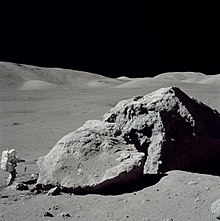
The first leap in lunar observation was caused by the invention of the telescope. Galileo Galilei made especially good use of this new instrument and observed mountains and craters on the Moon's surface.
The Cold War-inspired space race between the Soviet Union and the United States of America led to an acceleration of interest in the Moon. Unmanned probes, both flyby and impact/lander missions, were sent almost as soon as launcher capabilities would allow. What was the next big step depends on the political viewpoint: In the US (and the West in general) the landing of the first humans on the Moon in 1969 is seen as the culmination of the space race. Neil Armstrong became the first person to walk on the Moon as the commander of the American mission Apollo 11 by first setting foot on the Moon at 02:56 UTC on July 21, 1969. The last person (as of 2006) to stand on the Moon was Eugene Cernan, who as part of the mission Apollo 17 walked on the Moon in December 1972. The USA Moon landing and return was enabled by several technologies where the US surpassed the Russians; for example, the US achieved considerable advances in ablation chemistry and atmospheric re-entry technology in the early 1960s. On the other hand, many scientifically important steps, such as the first photographs of the until then unseen far side of the Moon in 1959, were first achieved by the Soviet Union. Moon samples have been brought back to Earth by three Luna missions (Luna 16, 20, and 24) and the Apollo missions 11 through 17 (excepting Apollo 13, which aborted its planned lunar landing).

Multiple scientific instruments were installed during the Apollo missions; some of them still function today. Among those were seismic detectors and reflecting prisms for laser ranging.
From the mid-1960s to the mid-1970s, there were 65 Moon landings (with 10 in 1971 alone), but after Luna 24 in 1976 they stopped. The Soviet Union started focusing on Venus and space stations and the US on Mars and beyond. In 1990 Japan orbited the Moon with the Hiten spacecraft, becoming the third country to get a spacecraft into moon orbit. The spacecraft released the Hagormo probe into lunar orbit, but the transmitter failed rendering the mission scientifically useless.
In 1994, the US finally returned to the Moon, robotically at least, sending Clementine, a Joint Defense Department/NASA mission which completed the first global multispectral data set for the Moon. This was followed by the Lunar Prospector mission in 1998, the third mission in the Discovery Program. The neutron spectrometer on Lunar Prospector confirmed the presence of excess hydrogen at the lunar poles, which some have speculated to be due to the presence of water.
On January 14 2004, US President George W Bush called for a plan to return manned missions to the Moon by 2020. The European Space Agency also has plans to launch probes to explore the Moon in the near future. European spacecraft Smart 1 was launched September 27 2003 and entered lunar orbit on November 15 2004. The People's Republic of China has expressed ambitious plans for exploring the Moon and has started the Chang'e program for lunar exploration. Japan has two planned lunar missions, LUNAR-A and Selene, and a manned lunar base is planned by the Japanese Space Agency (JAXA). India is to launch an unmanned mission Chandrayaan-1 in 2007.
Human understanding of the Moon

The Moon has been the subject of many works of art and literature and the inspiration for countless others. It is a motif in the visual arts, the performing arts, poetry, prose and music. A 5,000 year old rock carving at Knowth, Ireland may represent the Moon, which would be the earliest depiction discovered.
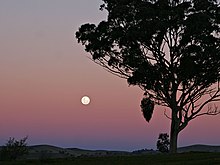
In many prehistoric and ancient cultures, the Moon was thought to be a deity or other supernatural phenomenon, and astrological views of the Moon continue to be propagated today. For further details, see The Moon in mythology. Among the first in the Western world to offer a scientific explanation for the Moon was the Greek philosopher Anaxagoras, who reasoned that the Sun and Moon were both giant spherical rocks, and that the latter reflected the light of the former. His atheistic view of the heavens was one cause for his imprisonment and eventual exile.
By the Middle Ages, before the invention of the telescope, more and more people began to recognize the Moon as a sphere, though they believed that it was "perfectly smooth".
In 1609, Galileo Galilei drew one of the first telescopic drawings of the Moon in his book Sidereus Nuncius and noted that it was not smooth but had mountains and craters. Later in the 17th century, Giovanni Battista Riccioli and Francesco Maria Grimaldi drew a map of the Moon and gave many craters the names they still have today.
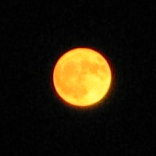
On maps, the dark parts of the Moon's surface were called maria (singular mare) or seas, and the light parts were called terrae or continents. The possibility that the Moon could contain vegetation and be inhabited by selenites was seriously considered by some major astronomers even into the first decades of the 19th century.
In 1835, the Great Moon Hoax fooled some people into thinking that there were exotic animals living on the Moon. Almost at the same time however (during 1834–1836), Wilhelm Beer and Johann Heinrich Mädler were publishing their four-volume Mappa Selenographica and the book Der Mond in 1837, which firmly established the conclusion that the Moon has no bodies of water nor any appreciable atmosphere.
There remained some controversy over whether features on the Moon could undergo changes. Some observers claimed that some small craters had appeared or disappeared, but in the 20th century it was determined that these claims were illusory, due to observing under different lighting conditions or due to the inadequacy of earlier drawings. It is however known that the phenomenon of outgassing occasionally occurs.
During the Nazi era in Germany, the Welteislehre theory, which claimed the Moon was made of solid ice, was promoted by Nazi leaders.
The far side of the Moon remained completely unknown until the Luna 3 probe was launched in 1959, and was extensively mapped by the Lunar Orbiter program in the 1960s.
From the 1950s through the 1990s, NASA aerodynamicist Dean Chapman and others advanced the lunar origin theory of tektites. Chapman used complex orbital computer models and extensive wind tunnel tests to support the theory that the so-called Australasian tektites originated from the Rosse ejecta ray of the large crater Tycho on the Moon's nearside. Until the Rosse ray is sampled, a lunar origin for these tektites cannot be ruled out.
In 1997 the asteroid 3753 Cruithne was found to have an unusual Earth-associated orbit, and has been dubbed by some to be a second moon of Earth. It is not considered a moon by astronomers, however, and its orbit is not stable in the long term.
Meteor impact on the Moon
An impact event was observed by NASA scientist Rob Suggs and astronomer Bill Cooke while testing out a new 10-in telescope and video camera they had assembled to monitor the Moon for meteor strikes. After consulting star charts they concluded that the impact body was probably part of the Taurid meteor shower. This may well be the first recording of this type of lunar event which some have claimed to have witnessed in the past.
Legal status
Though several flags of the Soviet Union and the United States have been symbolically planted on the Moon, the Russian and U.S. governments make no claims to any part of the Moon's surface. Russia and the U.S. are party to the Outer Space Treaty, which places the Moon under the same jurisdiction as international waters (res communis). This treaty also restricts use of the Moon to peaceful purposes, explicitly banning weapons of mass destruction (including nuclear weapons) and military installations of any kind. A second treaty, the Moon Treaty, was proposed to restrict the exploitation of the Moon's resources by any single nation, but it has not been signed by any of the space-faring nations.
Several individuals have made claims to the Moon in whole or in part, though none of these claims are generally considered credible (see Extraterrestrial real estate).
Artificial satellites
- Clementine mission – Observation and research satellite
- Smart 1 (or SMART-1) – a European Space Agency research satellite
- Chandrayaan (planned)
See also
- 2002 AA29
- Apollo Moon landing hoax accusations
- Blue moon
- Chang'e (mythology), Chinese moon goddess
- Colonization of the Moon
- Crescent
- Cruithne, sometimes claimed to be Earth's second moon
- Detailed image of an almost full Moon
- Earthshine
- Libration
- List of solar system bodies formerly considered planets
- Lunar effect
- Lunar geologic timescale
- Lunar mare
- Lunar meteorite
- Lunar phase
- Lunar standstill
- Lunar space elevator
- Moon in art and literature
- Moon landing
- Moonlight
- New moon
- Neil Armstrong and Buzz Aldrin, the first people to land on the Moon
- Perigee
- Project Apollo
- Saber's Beads
- Selene, Greek moon goddess
- Transient lunar phenomenon
Lunar location listings
- List of artificial objects on the Moon
- List of craters on the Moon
- List of features on the Moon
- List of maria on the Moon
- List of mountains on the Moon
- List of valleys on the Moon
References
Cited references
- Onasch, Bernd (2006). "Moon". Retrieved 2006-03-20.
- "Moon Fact Sheet". NSSDC. Retrieved 2006-03-20.
- "Welcome to the double planet". European Space Agency (ESA). 2003-10-05. Retrieved 2006-08-17.
{{cite web}}: Check date values in:|date=(help) - "IAU Q & A". International Astronomical Union (IAU). Retrieved 2006-10-24.
- Jones, J H. "Tests of the giant impact hypothesis" (PDF). Retrieved 2006-07-09.
- Kleine, Thorsten (2005). "Hf-W Chronometry of Lunar Metals and the Age and Early Differentiation of the Moon". Science. 310 (5754): 1671–1674. doi:10.1126/science.1118842.
{{cite journal}}: Unknown parameter|coauthors=ignored (|author=suggested) (help); Unknown parameter|month=ignored (help) - "PIA00131: Moon - False Color Mosaic". Retrieved 2006-03-20.
- Sarah Dunkin (1999). "Physics Web: New views of the Moon". Physics Web. Retrieved 2006-10-09.
{{cite web}}: Unknown parameter|coauthors=ignored (|author=suggested) (help); Unknown parameter|month=ignored (help) - J. Levine, T. A. Becker, R. A. Muller, P. R. Renne. "Ar/Ar dating of Apollo 12 impact spherules". Geophys. Res. Lett. 32, : L15201. doi:10.1029/2005GL022874.
{{cite journal}}: Text "year 2005" ignored (help)CS1 maint: extra punctuation (link) CS1 maint: multiple names: authors list (link) - T. S. Culler, T. A. Becker, R. A. Muller, P. R. Renne (2000). "Lunar Impact History from Ar/Ar Dating of Glas Spherules". Science. 287: 1785–1788.
{{cite journal}}: CS1 maint: multiple names: authors list (link) - "Clementine Images on the Moon". Retrieved 2006-03-20.
- "Lunar Polar Composites" (GIF). Retrieved 2006-03-20.
- Spekkens, Kristine (2002). "Is the Moon seen as a crescent (and not a "boat") all over the world?". Curious About Astronomy. Retrieved 2006-03-20.
{{cite web}}: Unknown parameter|month=ignored (help) - Olivier Knox (2004). "US President Calls For Moon, Mars Missions In New NASA Focus". Space Daily. Retrieved 2006-10-13.
{{cite web}}: Unknown parameter|month=ignored (help) - "Space Today Online". Retrieved 2006-10-08.
- R. J. Brown. "The Great Moon Hoax of 1835". HistoryBuff. Retrieved 2006-10-10.
- "No, it's not our "second" moon!!!". Retrieved 2006-10-10.
- "Nasa team sees explosion on Moon". BBC News. 2006. Retrieved 2006-03-20.
{{cite web}}: Unknown parameter|month=ignored (help) - "Eyewitness Moon Impact Debunked, Tagish Lake: Mystery Meteorite". Sky & Telescope's News Bulletin. Sky Publishing. 2001.
{{cite journal}}: Unknown parameter|month=ignored (help) - Whilst no Soviet flags have been hand-placed, Soviet coats of arms were scattered by Luna 2 in 1959, and similar devices by later landing missions
General references
- Ben Bussey and Paul Spudis, The Clementine Atlas of the Moon, Cambridge University Press, 2004, ISBN 0-521-81528-2.
- Patrick Moore, On the Moon, Sterling Publishing Co., 2001 edition, ISBN 0-304-35469-4.
- Paul D. Spudis, The Once and Future Moon, Smithsonian Institution Press, 1996, ISBN 1-56098-634-4.
- NASA fact sheet
- Klein, T., Palme, H., Mezger, M., Halliday, A. N., 2005. Hf-W chronometry of lunar metals and the age and early differentiation of the Moon. Science, v.310(5754) 1671-1674.
- Crust composition selected from Ahrens, Global Earth Physics : A Handbook of Physical Constants, American Geophysical Union (1995). ISBN 0-87590-851-9
External links
Moon phases
- Full Moon Names:
- U.S. Naval Observatory: phase of the Moon for any date and time 1800-2199 A.D.
- Current Moon Phase
- Display current moon phase as wallpaper in Windows
Space missions
- The Apollo Lunar Surface Journal (NASA) — Definitive history of Apollo lunar exploration programme.
- Assembled Panoramas from the Apollo Missions
- Digital Lunar Orbiter Photographic Atlas of the Moon
- The Project Apollo Archive
- Clementine Lunar Image Browser
Scientific
- The Moon – by Rosanna and Calvin Hamilton
- The Moon – by Bill Arnett
- Inconstant Moon – by Kevin Clarke
- The Moon Society (non-profit educational site)
- Geologic History of the Moon by Don Wilhelms
- Origin of the Moon - computer model of accretion subsequent to computer model of collision
Myth and folklore
- Do things get crazy when the moon is full? by Cecil Adams
- Once in a Blue Moon – What is a blue moon? by Ann-Marie Imbornoni
- The Moon In Folklore – by Virginia Marin
- The Rabbit in the Moon – by John Hardy
Others
- USGS Planetary GIS webserver – the Moon
- Why does the Moon appear bigger near the horizon? (from The Straight Dope)
- Bad Astronomy: Dr. Philip Plait, an astronomy professor at Sonoma State University, California, runs this site to explain the many cases of incorrect astronomy (and physics) available to the public, including astrology and the Apollo moon landing hoax accusations.
- The Lunar Navigator: Interactive Maps Of The Moon features free, interactive online access to maps of the Moon's surface
- A comprehensive guide to the Earth's Moon – moonpeople.com (Includes a discussion forum)
- Distance from the Earth to the Moon, illustrated
- 3D VRML Moon globe
- 3D maps of Moon in NASA World Wind
- Google Moon A view of the moon, including a reference to the myth that the moon is made of cheese.
- The Moon Earths nearest celestial neighbor presented by Utah Skies
- The Two Sides of the Moon An ABC Science online feature: Geoscientific debate about the origins of the Moon
- Lunar Photo of the Day Lunar scientist Charles A. Wood's lunar counterpart to the Astronomy Picture of the Day
- Corkscrew Asteroids (PhysOrg.com), Asteroid 2003 YN107 as Earth's "second moon"
- Space.com: All About the Moon Moon Reference and News
- Geody Moon World's search engine that supports NASA World Wind, Celestia, and other applications.
- moons.de The artist's moon - Graphical interfaces & semiotic netart around the Moon.
- Earthsim Virtual globe including detailed 3D moon.
| Natural satellites of the Solar System | ||
|---|---|---|
| Planetary satellites of |   | |
| Dwarf planet satellites of | ||
| Minor-planet moons | ||
| Ranked by size | ||
Template:Link FA Template:Link FA Template:Link FA Template:Link FA Template:Link FA Template:Link FA Template:Link FA Template:Link FA Template:Link FA
Categories: